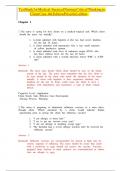Exam (elaborations)
Test-Bank-for-Medical-Surgical-Nursing-Critical-Thinking-in-Client-Care, 4th Edition by Priscilla LeMone
Course
Medical-Surgical-Nursing
Institution
Medical-Surgical-Nursing
Test-Bank-for-Medical-Surgical-Nursing-Critical-Thinking-in-Client-Care, 4th Edition by Priscilla LeMone
Test-Bank-for-Medical-Surgical-Nursing-Critical-Thinking-in-Client-Care, 4th Edition by Priscilla LeMone
Test-Bank-for-Medical-Surgical-Nursing-Critical-Thinking-in-Client-Care, 4th Edition by...
[Show more]
Preview 4 out of 522 pages
Uploaded on
October 31, 2024
Number of pages
522
Written in
2024/2025
Type
Exam (elaborations)
Contains
Questions & answers
Institution
Medical-Surgical-Nursing
Course
Medical-Surgical-Nursing
$17.99
100% satisfaction guarantee
Immediately available after payment
Both online and in PDF
No strings attached
Test Bank for Medical-Surgical Nursing Critical Thinking in




